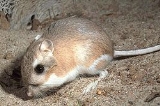
Glires
Encyclopedia
Glires is a clade
(sometimes ranked
as grandorder) consisting of rodents and lagomorphs
(rabbit
s, hare
s, and pika
s). This hypothesis that these form a monophyletic group has been long debated based on morphological evidence, although recent morphological studies strongly support monophyly of Glires (Meng and Wyss, 2001; Meng et al., 2003). In particular, the discovery of new fossil
material of basal
members of Glires, particularly the genera
Mimotona, Gomphos
, Heomys, Matutinia, Rhombomylus, and Sinomylus, has helped to bridge the gap between more typical rodents and lagomorphs (Meng et al., 2003; Asher et al., 2005). Data based on nuclear
DNA support Glires as a sister of Euarchonta
to form Euarchontoglires
(Murphy et al. and Madsen et al. 2001), but some genetic data from both nuclear and mitochondrial DNA
have been less supportive (Arnason et al. 2002). A study investigating retrotransposon
presence/absence data
unambiguously supports the Glires hypothesis (Kriegs et al. 2007).
Clade
A clade is a group consisting of a species and all its descendants. In the terms of biological systematics, a clade is a single "branch" on the "tree of life". The idea that such a "natural group" of organisms should be grouped together and given a taxonomic name is central to biological...
(sometimes ranked
Taxonomic rank
In biological classification, rank is the level in a taxonomic hierarchy. Examples of taxonomic ranks are species, genus, family, and class. Each rank subsumes under it a number of less general categories...
as grandorder) consisting of rodents and lagomorphs
Lagomorpha
The lagomorphs are the members of the taxonomic order Lagomorpha, of which there are two living families, the Leporidae , and the Ochotonidae...
(rabbit
Rabbit
Rabbits are small mammals in the family Leporidae of the order Lagomorpha, found in several parts of the world...
s, hare
Hare
Hares and jackrabbits are leporids belonging to the genus Lepus. Hares less than one year old are called leverets. Four species commonly known as types of hare are classified outside of Lepus: the hispid hare , and three species known as red rock hares .Hares are very fast-moving...
s, and pika
Pika
The pika is a small mammal, with short limbs, rounded ears, and short tail. The name pika is used for any member of the Ochotonidae, a family within the order of lagomorphs, which also includes the Leporidae . One genus, Ochotona, is recognised within the family, and it includes 30 species...
s). This hypothesis that these form a monophyletic group has been long debated based on morphological evidence, although recent morphological studies strongly support monophyly of Glires (Meng and Wyss, 2001; Meng et al., 2003). In particular, the discovery of new fossil
Fossil
Fossils are the preserved remains or traces of animals , plants, and other organisms from the remote past...
material of basal
Basal (phylogenetics)
In phylogenetics, a basal clade is the earliest clade to branch in a larger clade; it appears at the base of a cladogram.A basal group forms an outgroup to the rest of the clade, such as in the following example:...
members of Glires, particularly the genera
Genus
In biology, a genus is a low-level taxonomic rank used in the biological classification of living and fossil organisms, which is an example of definition by genus and differentia...
Mimotona, Gomphos
Gomphos
Gomphos is an extinct genus of early lagomorph from the early Eocene some 55 million years ago of China and Mongolia. The type species is G. elkema.-Sources:* The Beginning of the Age of Mammals by Kenneth D. Rose...
, Heomys, Matutinia, Rhombomylus, and Sinomylus, has helped to bridge the gap between more typical rodents and lagomorphs (Meng et al., 2003; Asher et al., 2005). Data based on nuclear
Cell nucleus
In cell biology, the nucleus is a membrane-enclosed organelle found in eukaryotic cells. It contains most of the cell's genetic material, organized as multiple long linear DNA molecules in complex with a large variety of proteins, such as histones, to form chromosomes. The genes within these...
DNA support Glires as a sister of Euarchonta
Euarchonta
The Euarchonta are a grandorder of mammals containing four orders: the Dermoptera or colugos, the Scandentia or treeshrews, the extinct Plesiadapiformes, and the Primates....
to form Euarchontoglires
Euarchontoglires
Euarchontoglires is a clade of mammals, the living members of which are rodents, lagomorphs, treeshrews, colugos and primates .-Evolutionary relationships:...
(Murphy et al. and Madsen et al. 2001), but some genetic data from both nuclear and mitochondrial DNA
Mitochondrial DNA
Mitochondrial DNA is the DNA located in organelles called mitochondria, structures within eukaryotic cells that convert the chemical energy from food into a form that cells can use, adenosine triphosphate...
have been less supportive (Arnason et al. 2002). A study investigating retrotransposon
Retrotransposon
Retrotransposons are genetic elements that can amplify themselves in a genome and are ubiquitous components of the DNA of many eukaryotic organisms. They are a subclass of transposon. They are particularly abundant in plants, where they are often a principal component of nuclear DNA...
presence/absence data
Retrotransposon Marker
Retrotransposon markers are retrotransposons that are used as cladistic markers.The analysis of SINEs – Short INterspersed Elements – LINEs – Long INterspersed Elements – or truncated LTRs – Long Terminal Repeats – as molecular cladistic markers represents a particularly interesting complement to...
unambiguously supports the Glires hypothesis (Kriegs et al. 2007).

